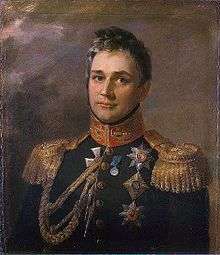Mikhail Semyonovich Vorontsov
| Prince Mikhail Vorontsov | |
|---|---|
 His portrait by George Dawe, from the Military Gallery of the Winter Palace (1825) | |
| Born |
30 May 1782 Saint Petersburg, Imperial Russia |
| Died |
18 November 1856 (aged 74) Odessa, Imperial Russia |
| Buried at | Transfiguration Cathedral in Odessa |
| Allegiance | Imperial Russia |
| Service/branch | Imperial Russian Army |
| Years of service | 1803-1856 |
| Rank | Field Marshal |
| Battles/wars |
Pułtusk; Friedland; Russo-Turkish War (1806–12) |
| Spouse(s) | Elizabeth Branicka Vorontsov |
Prince Mikhail Semyonovich Vorontsov (Russian: Михаи́л Семёнович Воронцо́в) (30 May 1782–18 November 1856), was a Russian prince and field-marshal, renowned for his success in the Napoleonic wars, and most famous for his participation in the Caucasian War from 1844 to 1853.
Life
The son of Count Semyon Vorontsov and nephew of the imperial chancellor Alexander Vorontsov, he was born on 17 May 1782, in Saint Petersburg.[1] He spent his childhood and youth with his father in London, where his father was ambassador.[2][3] During 1803–1804 he served in the Caucasus under Pavel Tsitsianov and Gulyakov. From 1805 to 1807, he served in the Napoleonic wars, and was present at the battles of Pułtusk and Friedland. From 1809 to 1811 he participated in the Russo-Turkish War.
He commanded the composite grenadiers division in Prince Petr Bagration's Second Western Army during Napoleon's invasion of Russia in 1812. At the battle of Borodino his division was in the front line and was attacked by three French divisions under Marshal Davout. Of the 4,000 men in his division only 300 survived the battle. Vorontsov was wounded, but recovered to rejoin the army in 1813. He commanded a new grenadiers division and fought at the battle of Dennewitz and the battle of Leipzig. He was the commander of the corps of occupation in France from 1815 to 1818.

On 7 May 1823 he was appointed governor-general of New Russia, as the southern provinces of the empire were then called, and namestnik of Bessarabia. The year of the start of the Russo-Turkish War of 1828–1829 Vorontsov succeeded the wounded Menshikov as commander of the forces besieging Varna, which he captured on 28 September 1828. But perhaps the best remembered of all is his wife's (née Countess Branicka) liaison with Alexander Pushkin during the latter's stay in Odessa, which resulted in some of the finest poems in Russian language.
In 1844, Vorontsov was appointed commander-in-chief and viceroy of the Caucasus. For military details see Murid War. At the Battle of Dargo (1845) he was nearly defeated and barely fought his way out of the Chechen forest. By 1848 he had captured two-thirds of Daghestan, and the situation of the Russians in the Caucasus, so long almost desperate, was steadily improving. For his campaign against Shamil he was raised to the dignity of prince, with the title of Serene Highness. In the beginning of 1853, Vorontsov was allowed to retire because of his increasing infirmities. He was made a field-marshal in 1856, and died the same year at Odessa. His archives were published, in 40 volumes, by Pyotr Bartenev between 1870 and 1897.

The Odessa statue of Prince Vorontsov was unveiled in 1863. In front of the monument stands the Odessa Cathedral with the marble tombs of Prince Vorontsov and his wife. After the Soviets demolished the cathedral in 1936, Vorontsov's remains were secretly reburied at a local cemetery. The cathedral was rebuilt in the early 2000s. The remains of Vorontsov and his wife were solemnly transferred to the church in 2005.
Notes
- ↑ Cave 1857.
- ↑ Keegan, John. Wheatcroft, Andrew. Who's Who in Military History: From 1453 to the Present Day Routledge, 12 mei 2014 ISBN 978-1136414169
- ↑ 'The Encyclopædia Britannica: A Dictionary of Arts, Sciences, Literature and General Information Vol. 28 At the University Press, 1911 (original from the University of Virginia) page 2013
References
- Blanch, Lesley (1960). The Sabres of Paradise. London: John Murray. ISBN 9781850434030.
- Gammer, Moshe. Muslim Resistance to the Tsar: Shamil and the Conquest of Chechnia and Daghestan. Frank Cass & Co., London, 1994. ISBN 0-7146-3431-X.
- Rhinelander, Anthony L. H. (1990). Prince Michael Vorontsov: Viceroy to the Tsar. Montreal, Quebec; Kingston, ON: McGill-Queen's University Press. ISBN 0-7735-0747-7.
- Robbins, Richard G.; Rhinelander, Anthony L. H. (October 1991). "Review: Prince Michael Vorontsov: Viceroy to the Tsar". The American Historical Review. The American Historical Review, Vol. 96, No. 4. 96 (4): 1243–1244. doi:10.2307/2165141. JSTOR 2165141.
- "Prince Woronzoff". Gentleman's Magazine. 202. Edw. Cave. 1857. p. 107.
- Attribution
![]() This article incorporates text from a publication now in the public domain: Chisholm, Hugh, ed. (1911). "article name needed". Encyclopædia Britannica (11th ed.). Cambridge University Press.
This article incorporates text from a publication now in the public domain: Chisholm, Hugh, ed. (1911). "article name needed". Encyclopædia Britannica (11th ed.). Cambridge University Press.
External links
- Online museum of the Vorontsov Family
- Mikeshin, Mikhail. "Mikhail Vorontsov: A Metaphysical Portrait in the Landscape".
| Government offices | ||
|---|---|---|
| Preceded by Ivan Inzov as acting Governor-General |
Governor-General of Novorossiya and Viceroy of Bessarabia Region 19 May 1823 – 5 November 1844 |
Succeeded by Fyodor Palen |
| Preceded by Aleksandr Neidgardt as High Commissioner of Caucasus |
Viceroy of Caucasus 1844 – 1854 |
Succeeded by Nikolai Read as acting Viceroy |